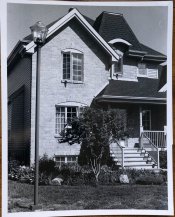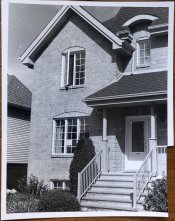I finally got around trying out the rolls I bought online. I shot them in my Nikon F, at box speed, and developed in D-76 stock.
- This film can build density! I initially developed at 6 minutes, and I backed down to 5. I think this would be a lovely film to make negatives to print as 35mm slides on 5302 (well, duh!), which is a cine print film. Shoot in camera, develop to a good contrast, and then contact print onto positive film, voilà! No need to buy a reversal kit, and you have some more latitude to adjust contrast. You can do it all with D76 and Dektol, or go the extra mile and mix your D-96 (for the 5222) and D-97 (for the 5302), like the pros.
- Side by side with Tri-X in D76 stock, the tonality is very much the same. The spectral sensibility curves of either film, while not identical, have the same peaks and valleys; Double-X has a very straight curve, and doesn't have the slight shoulder of Tri-X, though (hence the density).
- Double-X will give slightly better sharpness, and slightly bigger grain. Again, the MTF curves show that Double-X has a higher MTF than Tri-X for large details, but a lower one for fine details. You'll get nicely sharp edges, but not that super-fine-detail of low ISO films. It's a very agreeable grain in D-76. I think this is the "sharp, but grainy" that some people are looking high and low for. I have to try this on an 11x14 (haven't gone beyond 8x10 yet).
- Given that this film is meant to be enlarged a gazillion times on a movie screen, I think that its best qualities might not all be visible at typically enlarging sizes. However, if you think of this film as an "alternate universe" Tri-X, then you might find this interesting. Meaning that if you work a lot with Tri-X and want something slightly different (sometimes it's those small differences that count!), then you should definitely try it out.
I'll see if I can put some pictures up.
- This film can build density! I initially developed at 6 minutes, and I backed down to 5. I think this would be a lovely film to make negatives to print as 35mm slides on 5302 (well, duh!), which is a cine print film. Shoot in camera, develop to a good contrast, and then contact print onto positive film, voilà! No need to buy a reversal kit, and you have some more latitude to adjust contrast. You can do it all with D76 and Dektol, or go the extra mile and mix your D-96 (for the 5222) and D-97 (for the 5302), like the pros.
- Side by side with Tri-X in D76 stock, the tonality is very much the same. The spectral sensibility curves of either film, while not identical, have the same peaks and valleys; Double-X has a very straight curve, and doesn't have the slight shoulder of Tri-X, though (hence the density).
- Double-X will give slightly better sharpness, and slightly bigger grain. Again, the MTF curves show that Double-X has a higher MTF than Tri-X for large details, but a lower one for fine details. You'll get nicely sharp edges, but not that super-fine-detail of low ISO films. It's a very agreeable grain in D-76. I think this is the "sharp, but grainy" that some people are looking high and low for. I have to try this on an 11x14 (haven't gone beyond 8x10 yet).
- Given that this film is meant to be enlarged a gazillion times on a movie screen, I think that its best qualities might not all be visible at typically enlarging sizes. However, if you think of this film as an "alternate universe" Tri-X, then you might find this interesting. Meaning that if you work a lot with Tri-X and want something slightly different (sometimes it's those small differences that count!), then you should definitely try it out.
I'll see if I can put some pictures up.





